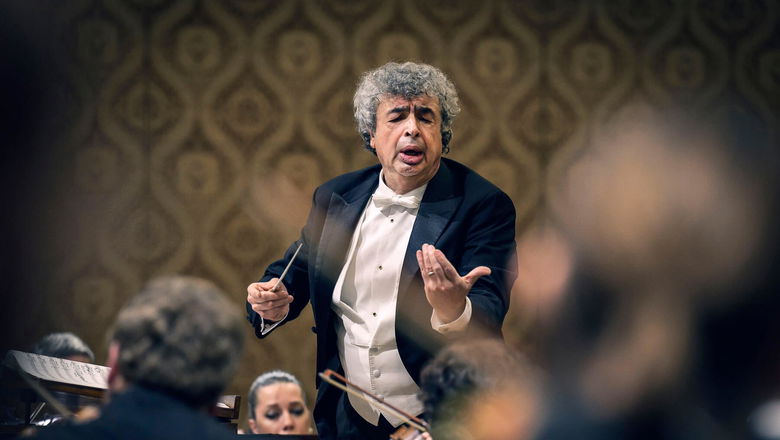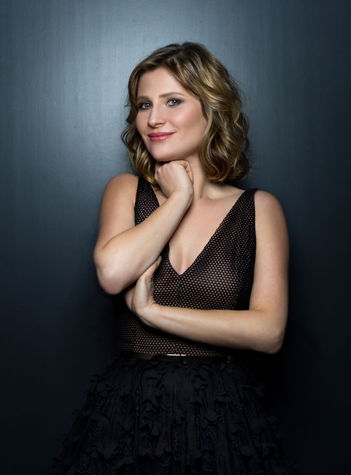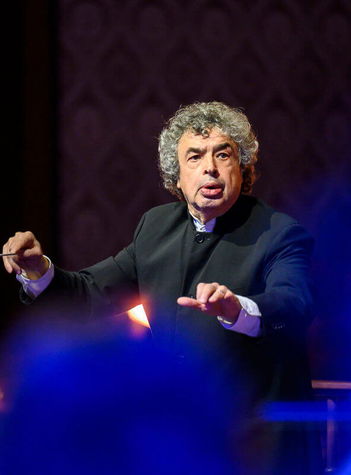Programme
Ludwig van Beethoven
Violin Concerto D major, Op. 61 (42')
— Intermission —
Richard Strauss
An Alpine Symphony, Op. 64 (47')
Secure your seat for the 2025/2026 season – presales are open.
Choose SubscriptionThe opening of the season is a gala event and deserves something special. The combination of works by Beethoven and Strauss with extra-musical associations meets this requirement, and with wonderful interpretations by the marvellous violinist Lisa Batiashvili and the Czech Philharmonic with Semyon Bychkov, these will be a truly special evenings.
Duration of the programme 1 hour 50 minutes
Ludwig van Beethoven
Violin Concerto D major, Op. 61 (42')
— Intermission —
Richard Strauss
An Alpine Symphony, Op. 64 (47')
Lisa Batiashvili violin
Semyon Bychkov conductor
Czech Philharmonic

“There is an interesting connection between Beethoven’s Violin Concerto and Strauss’s Alpine Symphony. The concerto is musically very closely tied to nature, and of course even just the title of the Alpine Symphony clearly suggests a work about nature. But that is actually a mistake because Strauss only uses nature as a metaphor for the life’s journey of a person from birth to death and for what happens to him along the way. So the Alpine Symphony is not about going through the forest or what you hear in the mountains. Everything in it operates as a story of the experiencing of human life. It is an absolutely existential work”, explains Maestro Semyon Bychkov.
The cameras in the auditorium record the first opening concert for a live broadcast on the Czech TV art channel and the second opening concert for a live broadcast on TV Mezzo Live HD.

Lisa Batiashvili violin

“Batiashvili’s fearless playing is so tonally rich and technically immaculate.” (The Guardian)
Lisa Batiashvili, the Georgian-born German violinist, is praised by audiences and fellow musicians for her virtuosity. An award winning artist, she has developed long-standing relationships with the world’s leading orchestras, conductors and musicians.
Batiashvili is also the Artistic Director of Audi Sommerkonzerte, Ingolstadt. For the 2019 festival – ‘Fantastique’ – Batiashvili curated a diverse programme featuring artists such as Daniel Harding with Bayerische Rundfunk Sinfonieorchester, Jean-Yves Thibaudet, Gautier Capuçon, Les Vents Francais and Kammerphilharmonie Bremen. For the 2020 festival, Batiashvili will design a programme to celebrate Audi’s anniversary year.
In the 2019/2020 season Batiashvili performs with, among others, the Philadelphia Orchestra / Yannick Nézet-Séguin, Berlin Staatskapelle / Daniel Barenboim, London Symphony Orchestra / Sir Simon Rattle, Orchestre de Paris / Lahav Shani, Gewandhausorchester Leipzig / Andris Nelsons, and Tonhalle-Orchester Zürich / Paavo Järvi.
Recording exclusively for Deutsche Grammophon, Lisa’s latest album – ‘Visions of Prokofiev’ (Chamber Orchestra of Europe / Yannick Nézet-Séguin) – won an Opus Klassik Award and was shortlisted for the 2018 Gramophone Awards. Earlier recordings include the concertos of Tchaikovsky and Sibelius (Staatskapelle Berlin / Daniel Barenboim), Brahms (Staatskapelle Dresden / Christian Thielemann), and Shostakovich No. 1 (Symphonieorchester des Bayerischen Rundfunks / Esa-Pekka Salonen).
Bastiashvili has had DVD releases of live performances with the Berliner Philharmoniker / Yannick Nézet-Séguin (Bartók Violin Concerto No.1) and with Gautier Capuçon, Sächsische Staatskapelle Dresden and Christian Thielemann (Brahm’s Concerto for Violin and Cello).
She has won several awards: the MIDEM Classical Award, the Choc de lʼannée, the Accademia Musicale Chigiana International Prize, the Schleswig-Holstein Music Festivalʼs Leonard Bernstein Award and the Beethoven-Ring. Batiashvili was named Musical America’s Instrumentalist of the Year in 2015, was nominated as Gramophone’s Artist of the Year in 2017, and in 2018 was awarded an Honorary Doctorate from the Sibelius Academy (University of Arts, Helsinki).
Lisa lives in Munich and plays a Joseph Guarneri “del Gesù” from 1739, generously loaned by a private collector.
For further information please visit the homepage http://lisabatiashvili.com/.
Semyon Bychkov conductor

In addition to conducting at Prague’s Rudolfinum, Semyon Bychkov and the Czech Philharmonic in the 2023/2024 season, took the all Dvořák programmes to Korea and across Japan with three concerts at Tokyo’s famed Suntory Hall. In spring, an extensive European tour took the programmes to Spain, Austria, Germany, Belgium, and France and, at the end of year 2024, the Year of Czech Music culminated with three concerts at Carnegie Hall in New York.
Among the significant joint achievements of Semyon Bychkov and the Czech Philharmonic is the release of a 7-CD box set devoted to Tchaikovsky’s symphonic repertoire and a series of international residencies. In 2024, Semjon Byčkov with the Czech Philharmonic concentrated on recording Czech music – a CD was released with Bedřich Smetanaʼs My Homeland and Antonín Dvořákʼs last three symphonies and ouvertures.
Bychkovʼs repertoire spans four centuries. His highly anticipated performances are a unique combination of innate musicality and rigorous Russian pedagogy. In addition to guest engagements with the world’s major orchestras and opera houses, Bychkov holds honorary titles with the BBC Symphony Orchestra – with whom he appears annually at the BBC Proms – and the Royal Academy of Music, who awarded him an Honorary Doctorate in July 2022. Bychkov was named “Conductor of the Year” by the International Opera Awards in 2015 and, by Musical America in 2022.
Bychkov began recording in 1986 and released discs with the Berlin Philharmonic, Bavarian Radio, Royal Concertgebouw, Philharmonia Orchestra and London Philharmonic for Philips. Subsequently a series of benchmark recordings with WDR Symphony Orchestra Cologne featured Brahms, Mahler, Rachmaninov, Shostakovich, Strauss, Verdi, Glanert and Höller. Bychkov’s 1993 recording of Tchaikovsky’s Eugene Onegin with the Orchestre de Paris continues to win awards, most recently the Gramophone Collection 2021; Wagner’s Lohengrin was BBC Music Magazine’s Record of the Year (2010); and Schmidt’s Symphony No. 2 with the Vienna Philharmonic was BBC Music Magazine’s Record of the Month (2018).
Semyon Bychkov has one foot firmly in the culture of the East and the other in the West. Born in St Petersburg in 1952, he studied at the Leningrad Conservatory with the legendary Ilya Musin. Denied his prize of conducting the Leningrad Philharmonic, Bychkov emigrated to the United States in 1975 and, has lived in Europe since the mid-1980’s. In 1989, the same year he was named Music Director of the Orchestre de Paris, Bychkov returned to the former Soviet Union as the St Petersburg Philharmonic’s Principal Guest Conductor. He was appointed Chief Conductor of the WDR Symphony Orchestra (1997) and Chief Conductor of Dresden Semperoper (1998).
Ludwig van Beethoven
Violin Concerto in D Major, Op. 61
The beginning of the new century was a major turning point in the life of Ludwig van Beethoven. While war was raging Europe because of the French Revolution, the composer was undergoing a deep personal crisis. Since about 1798 his hearing had been worsening gradually, and despite the efforts of physicians, this ultimately led to total deafness. This was an especially crushing blow for Beethoven, who had been earning a living mainly as a piano virtuoso since moving from his birthplace Bonn to Vienna. Consumed by his own problems, in April 1802 he moved to a quiet settlement on the outskirts of Vienna in the hope that his health would improve. Unfortunately, that did not occur. Beethoven was convinced that his worsening deafness portended the approaching end of his life. That autumn he wrote what we know as the Heiligenstadt Testament. In this moving letter that he wrote to his brothers but never sent, at just 32 years of age, Beethoven confesses that his worsening health has brought him suffering, and also admits that he had contemplated suicide. Ultimately, however, the composer rejected such thoughts, reconciled himself to his fate, and with growing determination fully devoted himself to a higher calling. In the years that followed, Beethoven gave himself over entirely to composing and began a new chapter of his artistic career, which his biographers have called his “heroic period”.
This is when he wrote his great Fifth Symphony as well as the Eroica and the Pastoral, the piano sonata known as the Apassionata, the first version of the opera Fidelio, and the Violin Concerto in D major. The composer wrote his only concerto for that instrument on commission for Franz Clement, the talented violinist, composer, and conductor at the Theater an der Wien. The premiere took place on 23 December 1806, and Beethoven had supposedly only finished the score a few days beforehand. It appears that the artistic quality of the premiere suffered because of insufficient rehearsal time. Although the audience gave the new work a cordial reception, the music critics were more reserved, and apart from a handful of performances the concerto was largely forgotten for another 38 years. The man behind its rediscovery in 1844 was the violin virtuoso Joseph Joachim, at the time just 14 years old, who performed it with great success at his London debut. Since then, Beethoven’s Violin Concerto has won a place in the standard repertoire as one of the pillars of the violin literature alongside the concertos of Brahms, Bruch, Mendelssohn, and Tchaikovsky.
The Violin Concerto in D major makes demands of the highest order on the performer. The three-movement work in the classical concerto mould is imbued with a lyrical mood that is unusual in comparison with Beethoven’s other works. Here, the heroism we noted above, as found for example in the Eroica or the piano concertos, yields to the composer’s admiration for pastoral motifs. In this regard, the middle movement (Larghetto) is especially remarkable. Beethoven used this very slow tempo indication only twice in his orchestral works. The first time was in his Second Symphony, which he completed while staying in Heiligenstadt. The solo violin part lies mostly in the very high register, and the melodic material is built from simple scales and arpeggios, while the orchestra serves mostly as a harmonic anchor, and the music’s pulse nearly comes to a halt in places. The overall effect is one of an intimate confession, but in the final bars of the movement, the mood is interrupted by a playfully virtuosic motif announcing the following Rondo.
The protagonist of this evening’s concert, Lisa Batiashvili, first played Beethoven’s concerto at age 18, and she still regards it as an exceptional work: “It is heavenly music that carries us away to another world. Beethoven wrote a work that is incredibly virtuosic, but one must still play it as lightly as possible. Especially in the last movement, you have to show what you are capable of, but at the same time you have the feeling that it is you who must serve the music, and not the other way around.”
Richard Strauss
An Alpine Symphony, Op. 64
“There is an interesting connection between Beethoven’s Violin Concerto and Strauss’s Alpine Symphony. The concerto is musically very closely tied to nature, and of course even just the title of the Alpine Symphony clearly suggests a work about nature,” said chief conductor Semyon Bychkov when introducing the Czech Philharmonic’s new season.
The music of Richard Strauss is firmly entrenched in the symphonic repertoire although its importance in the development of German symphonic music is sometimes overshadowed by some of his contemporaries, such as the giant of late Romanticism Gustav Mahler or the conqueror of tonality Arnold Schoenberg. In his early works, Strauss followed in the footsteps of the father of the symphonic poem Franz Liszt, and he produced some of the supreme achievements of that musical genre. The works that brought him success as a composer drew their thematic inspiration mainly from literature and philosophy. At the end of the 19th century, he wrote symphonic poems like Don Juan, Till Eulenspiegel, and Don Quixote. In reaction to Nietzsche’s philosophical novel Also sprach Zarathustra, he wrote a composition with the same title in 1896. With the arrival of the new century, Strauss was increasingly drawn to writing operas and works in other forms for voices and orchestra, and he devoted himself primarily such works in the years that followed.
After 1900, Richard Strauss wrote only two more symphonic poems, first the Symphonia Domestica (1903), then 12 years later the monumental Alpine Symphony. For his final work in the genre, Strauss took inspiration from his love of nature and from an adventure of his youth, when he and a group of friends set out to climb Heimgarten, a mountain peak in Bavaria. The Alps remained dear to Strauss’s heart all his life. In 1908, he had a house built in Garmisch-Partenkirchen in the Bavarian Alps, where he lived with a few brief interruptions until the end of his life. According to available sources, by 1899 Strauss had already started work on a musical treatment of the theme of an Alpine expedition with the title Tragedy of an Artist, but he later set the work aside, not returning to it until 1911, apparently in connection with the premature death of his close friend Gustav Mahler.
Strauss is often regarded as a master of orchestration, and in An Alpine Symphony he elevated the art of instrumentation to absolute perfection. The score calls for about 125 players, and apart from the usual instruments of the orchestra, there are parts for some less frequently employed instruments like organ, celesta, and Wagner tuba. Also unique is the use of a whole array of percussion including tam-tams, cowbells, and instruments that imitate the sound of the wind and thunder. There is also an off-stage band with 12 French horns, two trumpets, and two trombones. Despite its title, An Alpine Symphony is a single-movement symphonic poem divided into 22 short parts. The composition is framed by two sections titled Night, and between them it follows the progress of a mountaineering expedition in the Alps. Each episode symbolises a specific part of the journey or a time of day.
However, Semyon Bychkov says about the symphony’s programme: “An Alpine Symphony is not about a walk through the forest and what you hear while in the mountains. In it, Strauss is just using nature as a metaphor for life’s journey from birth to death and all the things that happen along the way. Everything in it works like a story about the experience of human life. It is an absolutely existential work.”
The opening of the season is a gala event and deserves something special. The combination of works by Beethoven and Strauss with extra-musical associations meets this requirement, and with wonderful interpretations by the marvellous violinist Lisa Batiashvili and the Czech Philharmonic with Semyon Bychkov, these will be a truly special evenings.